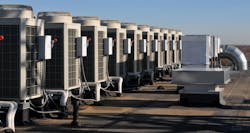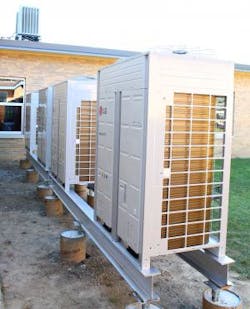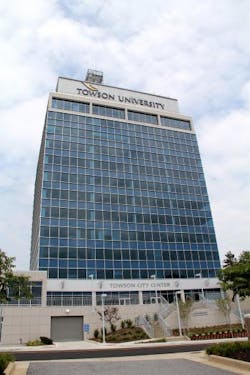Field Notes on Commercial VRF
Variable refrigerant flow (VRF) heating and air conditioning technology has found a secure footing as a comfort option for a variety of commercial HVAC applications. Here are two case studies of successful VRF installations. Comments are also included from contractors posting opinions on HVAC-Talk.com.
VRF Replaces School Boiler
Sycamore Elementary School, Dorr, MI, is just one example of a school where administrators are starting to pay attention to energy efficiency.
Sycamore Elementary School asked Vytau Virskus, with Millennium Energy, to help them replace their previously outdated boiler system with more effective and energy efficient HVAC system. The project needed a solution that not only had low energy consumption, but would also keep the children warm during the chilly Michigan winters and cool during the hot summers.
“We were looking for a system that would not only cut costs, but also provide a quiet and functional classroom environment for the students,” said Virskus, “We were also able to connect the unit to a dashboard that will measure the energy efficiency over time.”
After evaluating a variety of different options, Millennium Energy chose LG Electronics’ Multi V IV Air Cooled VRF Heat Pump system because of the quality and benefits it provided.
The Multi V IV is designed to meet the needs of a varying Michigan climate such as Michigan — which can have very cold winters and very hot spring/summer temperatures. The Multi V IV system allows teachers to heat or cool specific areas of the building simultaneously in an energy-efficient manner, which is a significant benefit over ducted systems. Rooms in direct sunlight can be kept cool, while rooms that receive no sun can be warmer. The LG Multi V IV also offers users a more compact product that is lighter in weight than any other model currently on the market, according to the company.
The flexible design enables the VRF system to adapt to any current setup a building can offer and requires fewer materials than other systems. For Sycamore Elementary, Virskus was able to integrate the HVAC system into the existing environment using the AC Smart Premium control system provided with the LG package.
‘Sick’ Building Cured with VRF Makeover
In 2002, a 15-story office tower in Towson, MD was diagnosed as a “sick” building, and closed due to major ventilation issues. Today, the Towson City Center is certified as a LEED Silver building, thanks in part to a VRF system from Mitsubishi.
Caves Valley Partners, a Towson-based real estate development firm, acquired the building in 2012, and was intent on reviving it through a state-of-the-art modernization program. The renovation included a new glass curtain wall façade and full-scale replacement of the 170,000 sq.ft. building’s electrical and mechanical systems.
The massive amount of work was completed by Mechanical Engineering & Construction Corp. (MEC2) of Baltimore.
Steve Wagner, director of engineering for MEC2, and company principal Rich Beattie, said the challenging work ahead of them include gutting the entire tower, with only structural steel, slabs, and elevator core left standing. Another challenge was working with the low deck height of the building’s original design. The space between floors measured only 10 ft., 6-in., not the usual 14-ft. found in most buildings. Therefore, a ducted HVAC solution was unworkable. Only a non-ducted solution would do, and keep the project a condender for LEED status.
The team selected a Mitsubishi VRF R2 Series zoning system, which helped the design team meet the challenges before them. They installed 15 rooftop units.
“It was combined with a dedicated outdoor air system (DOAS) providing all the ventilation to the building, which left the Mitsubishi system to be the heating and cooling component of the system. The system trades heat between the interior and exterior. So in the shoulder months you’re getting heating and cooling for free,” Wagner explained.
“Because the Mitsubishi multi-port controller makes the system so flexible, we were able to easily orchestrate the piping and wiring for each floor,” he continued. “It’s so much easier and less costly to install, that individual zoning becomes immediately available. When a building isn’t leased, and there’s no interor tenant improvement plan, this system allows you to install indoor fan coils when space becomes rented and rooms identified.
"We needed to integrate the system into a building management system. We had a separate BMS which controls many of the functions of the building. The Mitsubishi Electric system integrated seamlessly into that BMS, where we can access the data locally or remotely through any computer. It's all web-based.
According to Wagner, one of the main benefits of the Mitsubishi installation is that it’s a two-pipe system rather than a three-pipe system. This results in a reduced number of fittings.
“What we’ve found in the past and we’ve installed plenty of different systems, is that the labor it takes to complete the pipefitting is reduced with the Mitsubishi system, thus saving money,” he said.
Mitsubishi Electric’s low-profile (9 7/8-in.) indoor unit fan coils helped the design team overcome the ducting heigh limitations posed by the low decks. The Mitsubishi zoning technology earned the project 11 LEED energy points.
Commercial VRF Discussion Forum
On the Contracting Business HVAC-Talk.com discussion forum, contractors share their experiences with HVAC technology. Here's something of what these contractors had to say about their experiences with various commercial VRF systems. These comments are edited. You can visit these links for more of their comments: bit.ly/VFRchat1 and bit.ly/VRFchat2.
As a Commercial HVAC Contractor,
What Do You Say are Commercial VRF's Advantages?
A1: ”I’ve installed and serviced VRF systems from the ‘big three’ — Mitsubishi, Daikin, and LG. It’s nice to be running piping next to ancient hot and chilled water pipes, knowing that you don’t have to mess with those. Performance is almost never a question with equipment selection. The system modulates to load, so an indoor unit that’s slightly over-sized isn’t an issue.” — tech45
A2: ”The LG Multi V IV is a very good retrofit application, in areas where space is limited.” — controlsinmt
A3: ”In the very cold climate of Maine, VRF systems can’t really stand alone without making some considerations in heating mode. We did a 42-ton unit in a two-story bank office building. We had six condensers. That system works phenomenally well. We made provisions to use hydronic coils as the backup, to operate in extremely cold weather. My biggest complaint is that the building design engineers don’t understand them VRF products they design them in, so we wind up making modifications to the design from a technical perspective. They tend to draw piping layouts that don’t meet the manufacturer’s requirements, such as the distance from the BC (branch control) boxes — where the 3-pipe system splits — and the units.” — meplumber
A4: ”The drawback is the integration into a Tridium AX front-end. We’re using a BACnet interface, and it doesn’t seem to communicate as well as we were promised. The dead band from heating to cooling is also frustrating from an energy conservation standpoint. I believe the default is two degrees. We have it set at six degrees. So at a 72F set point, it should go to cooling at 75F and call for heat at 69F. That works, but it will stay in cooling until the area drops below 69F. The main occupant complaint we have been getting is the default “fan on” during cooling mode. This complaint is basically from the cassette style units in individual offices. The only way to have the fan off is to command it off or turn the unit to heating mode. Occupants do seem to get confused with the room controllers. They’re not the easiest things to set up.“ — controlsinmt
A5: “You can put three outdoor units together and serve 38 tons. They also seem to have less piping and refrigerant. Three-pipe systems are very nice. They essentially transfer heat from one room to another, as opposed to sending it out through the condenser if you have varying loads. as an example, you can remove BTUs from a server room all winter, and send them to the occupied space, instead of out through the roof. really makes a system efficient.” —flange
A6: ”VRF seems to perform well, in the end. Like any system, each job requires tweaking and time to sort out issues. The good: variable capacity throughout each zone by default; centralized control by default; definite rules of installation and practices; reliability due to constant monitoring from the system controls. The not so good: labor expectations (longer than some are promised); service clearances in occupied ceilings for BC controllers and branch selectors; wall hung units and condensate.” — tech 45
A7: ”Installers need to be a bit particular during the install, about keeping it clean and doing it right. For companies starting out, it can be hard to ‘get it together’ when starting out in the VRF world. You should anticipate some issues with installation when you start to offer VRF. Heating/cooling costs are typically quite a bit less after putting one of these in, aside from the ability to dehumidify, heat, and cool all at once.” — numbawunfela


